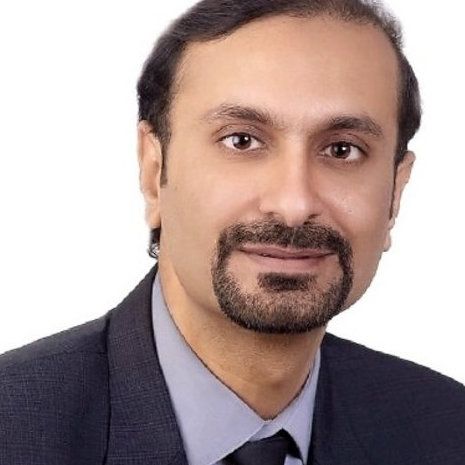Neupogen Biosimilar Nivestym Matches Efficacy for Allogeneic HSCT Donor Mobilization
A single-center cohort analysis showed the biosimilar provided similar PBSC mobilization to originator filgrastim.
Moazzam Shahzad, MBBS
Credit: ResearchGate

Biosimilar Nivestym was associated with similar efficacy for mobilizing peripheral blood stem cell (PBSC) compared to originator filgrastim (Neupogen) in allogeneic donors, according to findings from a single-center, retrospective analysis.1
Investigators from the University of Kansas Medical Center reported new data showing a biosimilar to the marketed granulocyte colony-stimulating factor (G-CSF) was linked to similar median output of PBSCs among adults ≥35 years old undergoing allogeneic hematopoietic stem cell transplantation (HSCT) donation. The findings implicate opportunities for consistent, cost-efficient procedures that would continue to benefit patients in need of HSCT.
Led by Moazzam Shahzad, MBBS, of the Moffit Cancer Center and University of Kansas, investigators sought to compare the efficacy of Nivestym to Neupogen for allogeneic donor PBSC mobilization. They described HSCT as an “optimal and potentially curative therapy” for patients with various hematologic diseases; G-CSF helps mobilize PBSCs in allogeneic doses, while a CD34 cell dose is critical for the transplantation as well.
“Nivestym, a biosimilar G-CSF to the originator filgrastim (Neupogen), is now used by multiple institutions as it has become more available; however, there is a lack of data in this regard among healthy donors for allogeneic HSCT mobilization,” they wrote.
Prior research has shown biosimilars for filgrastim have shown similarity in both autologous or allogeneic HSCT donor PBSC mobilization—with an added benefit for cost reduction to healthcare systems. “Using the average wholesale price of filgrastim and (biosimilar), it is estimated that the annual cost savings for the healthcare system when using (a biosimilar) in place of filgrastim for the HSCT mobilization is close to $90,000 per 120 patients,” a team of investigators wrote in a 2019 report. “In addition to the potential cost-savings that biosimilar products can have, they also can present a potential solution for managing drug shortages of biologic reference products.”2
Shahzad and colleagues conducted their retrospective cohort analysis using 541 adult allogeneic HSCT donors at the University of Kansas Medical Center who received Nivestym from January 2013 – July 2020 (n = 196), or Neupogen (n = 345) from July 2020 – June 2023, to mobilize donor PBSC. The team conducted a bivariate analysis comparing the 2 agents using ANOVA, with statistical significance determined at P <.05.
Median patient age was 47 years old (range, 17 – 76), and median donor weight was 86 kg (95% CI, 87 – 91). Donors receiving Neupogen had a similar white blood cell count (median 45 vs 47 K/uL, P = .739); CD34 percentages (17% vs 17%; P = .527); and circulating CD34 count (74 vs 74 million cells/kg; P =. 824) to the Nivestym arm prior to GCSF.
Investigators observed a similar median PBSC product total neutrophil count (TNC), product CD34 percentage, absolute CD34 count and final CD34 dose among the 2 treatment arms. They additionally reported a consistent rate of donors who needed 2 days of PBSC collection to achieve the target donor dose among those receiving Neupogen (n = 25 [7.3%]) and Nivestym (n = 13 [6.6%]).
What’s more, an age-stratified subgroup analysis showed donors aged ≥35 years old (n = 154) reported similar responses across all outcomes (P >.05), while donors <35 years old showed a greater median CD34 dose in donors receiving Neupogen versus Nivestym. Nearly all PBSC collections (98%) were completed in 1 day; 5 donors in each arm took longer.
“Biosimilar G-CSF (Nivestym) demonstrated similar efficacy for peripheral blood stem cell mobilization compared to the originator G-CSF (Neupogen) among allogeneic HSCT donors,” Shahzad and colleagues concluded. “In donors aged 35 years or younger, a slightly lower PBSC product CD34 count was noted with Nivestym compared to Neupogen.”
References
- Shahzad M, Al-Ramahi JS, Amin MJ, Khalid MF, et al. Comparison of Biosimilar Filgrastim (Nivestym) Versus Originator Filgrastim (Neupogen) for Peripheral Blood Stem Cell Mobilization for Allogeneic Hematopoietic Stem Cell Transplantation. Blood. Vol 142, Sup 1. Published November 28, 2023. https://doi.org/10.1182/blood-2023-185652
- Eplin DD, Jackson AD, Smith AM, Salvig B, Chinratanalab W, Savani BN. Use of Biosimilar Granulocyte Colony-Stimulating Factor for Mobilization in Autologous and Allogeneic Hematopoietic Stem Cell Transplantation. Clin Hematol Int. 2019;1(4):229-233. Published 2019 Oct 14. doi:10.2991/chi.d.191008.001